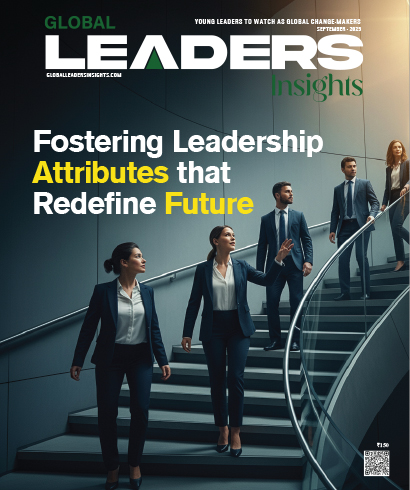The Shift from Reactive to Proactive Employee Relations
By Global Leaders Insights Team
.jpg)
In an exclusive conversation with Global Leaders Insights, David Mizzi, Global Head of Employee Relations at Atlassian, shares his vision for transforming Employee Relations (ER) into a proactive, strategic force within organisations. With over 20 years of global experience across technology, FMCG, professional services, and not-for-profit sectors, Mizzi reflects on how ER can evolve from a reactive support function into a driver of fairness, trust, and high-performing workplace culture. He highlights how modern ER, powered by data intelligence, AI, and human insight, integrates seamlessly with leadership and people strategies to anticipate risk, strengthen culture, and embed resilience across the employee lifecycle.
What Is Employee Relations?
Employee Relations (ER) is often misunderstood, yet it remains one of the most powerful value drivers in business. At its core, it is how an organisation manages its relationship with its people from how expectations are set, how conflict is resolved, and how fairness is upheld when the stakes are high.
In some organisations, ER operates as a specialist advisory team within HR, guiding leaders through performance challenges and early interventions. In others, it functions as a centre of excellence, managing investigations, designing consequence frameworks, and advising leaders on risk and change. Some environments lean on governance and compliance, while others view ER as a leadership coach and cultural compass, ensuring decisions reflect both company values and agility.
ER spans workplace investigations, policy design, restructures, performance management, behavioural coaching, and data-driven trend analysis. Increasingly, it extends across the employee lifecycle—from onboarding to exit—ensuring fairness and trust at every stage.
At its best, ER steadies the organisation through fairness and integrity, ensuring that even in difficult moments, company values and fairness is ensured in every decision made.
Rethinking the Role of Employee Relations
Every organisation faces moments that test its culture and how leaders respond under pressure, how employees are treated when things get difficult, and how decisions hold up under scrutiny.
The shift now underway is from reaction to foresight, from managing incidents to shaping the conditions that prevent them. The most effective organisations no longer see ER as a problem-solving function but as a strategic driver that builds leadership confidence, strengthens culture, and reinforces organisational credibility.
Also Read: AI Fails in Contact Centres due to Talent Crunch
The Business Case for Proactive Employee Relations
In today’s hyper-connected world, a single workplace issue can erode trust and damage employee sentiment and wellbeing. The boundaries between culture, brand, and leadership have blurred, and how an organisation treats its people has become a direct measure of performance that shapes retention, innovation, and reputation.
To meet this challenge, ER must evolve from a reactive support function into a strategic capability embedded in decision-making. The role of ER is no longer to manage problems after they occur but to anticipate them, interpret signals, and shape the conditions that prevent them. Proactive ER connects people and business systems to surface early risks, reveal insights, and enable leaders to act before challenges escalate.
This shift is most effective when ER operates within a unified people ecosystem aligned with the broader People and Culture strategy, including Centres of Excellence, Leadership, and Strategy. Together, these functions create a shared lens through which culture, behaviour, and performance can be understood, influenced, and strengthened.
When ER moves from reaction to foresight, it stops being the function that intervenes after issues arise and becomes the force that ensures things go right.
Embedding Employee Relations in Strategic Leadership
ER should be present at the leadership table from the beginning, helping to shape strategy, transformation, and organisational design rather than arriving later to implement decisions already made. Early partnership allows risks to be identified, challenges to be surfaced, and solutions to be designed with equal attention to people and business outcomes.
The journey toward foresight begins with visibility, understanding where decisions are made too late, where leaders lack clarity, or where insight is not being fully used. From there, ER maturity grows through stronger data flow, targeted leader capability, and the integration of ER thinking into planning and transformation cycles. The goal is not perfection but continuous progress toward insight-led decision-making.
A modern and proactive ER function is agile by design. Tiered operating models balance scale with expertise. Foundational teams manage intake and lower-risk matters, experienced practitioners lead complex cases, and senior ER leaders focus on analytics, culture, and foresight.
Leadership enablement is central to this evolution. Most ER issues surface first with managers, not HR. When leaders are equipped to listen early, act fairly, and resolve issues with confidence, problems rarely escalate. The role of ER is not to replace managers but to empower them, turning leadership into the organisation’s first and most effective line of prevention.
Proactive ER is not simply a different way of working. It is a different way of leading. It positions ER not as a responder to crises but as a driver of trust, performance, and cultural integrity.
Also Read: Accelerating India's Shift from Tech Execution to Ownership
Data Intelligence and Foresight in Modern Employee Relations
Modern ER is powered by data intelligence, not just process. Data, technology, and human insight now combine to form a proactive ER ecosystem capable of anticipating risks before they surface.
At the centre of this ecosystem is the ER Service Desk, a structured and confidential entry point for all ER matters that ensures privacy, consistency, and confidentiality. The service desk consolidates data across other respective systems, enabling ER teams to identify recurring themes, monitor emerging trends, and detect early signs of risk. Supported by advanced tooling, it tracks hot spots, trends, resolution patterns and employee sentiment to guide where attention is most needed.
Dashboards, case-management platforms, and analytics systems give leaders real-time visibility into workforce insights. When configured effectively, these systems integrate HR data, feedback mechanisms, and ER outcomes into a single view that allows timely and evidence-based action.
AI enhances this capability by analysing tone, clustering data, and identifying trends and hotspots that might otherwise go unnoticed. Used responsibly and transparently, AI enables ER to move from reporting to prediction—spotting potential problem areas before they escalate.
Technology, however, is only part of the equation. Data and AI point to what matters, but empathy, judgment, and integrity determine what happens next. The combination of strong governance, intelligent systems, and skilled practitioners transforms ER into both a strategic and preventative function. Intelligence informs leadership decisions, early interventions replace escalations, and trust is built not just by what ER does, but by how swiftly and fairly it acts.
The result is an ER function that does not merely measure success but enables it. By combining human expertise with data-driven insight, proactive ER transforms how organisations understand risk, shape culture, and sustain trust.
Designing ER for the Future
A future-ready ER function mirrors the business it supports, global in vision, agile in design, and powered by data and technology.
The strongest models use a hub-and-spoke structure where a central Centre of Excellence sets strategy and governance while embedded ER partners work closely with the business to sense risk and guide decisions. Tiered support ensures that the right matters reach the right expertise quickly.
Modern tooling brings this design to life. Case-management platforms, real-time dashboards, and AI-enabled analytics provide visibility, measure impact, and empower ER to advise leaders with precision. A well-designed structure ensures that information moves from the frontline to senior leadership fast enough to influence outcomes rather than react to them.
An agile ER function also integrates with enterprise risk, ethics, and culture forums, ensuring workforce insights inform strategic and board-level discussions. When ER data is reviewed alongside safety, finance, and reputation metrics, it reinforces a simple truth: people risk is business risk.
Also Read: Why the Recent Layoffs are a Turning Point for the Indian IT Sector to Adapt and Innovate
The Path Forward: Integration and Foresight
The evolution of ER is not about more policies, it is about smarter partnerships. Culture, leadership, and performance are interdependent, and trust is the thread that holds them together.
The future of people leadership depends on integration. Centres of Excellence, Leadership, and Strategy must operate as one system—one people team focused on trust, performance, and foresight.
When ER begins with insight rather than intervention, when leaders act early and fairly, and when trust becomes a measurable asset, organisations stop reacting and start leading with confidence.
For senior leaders, this is not about adding another function. It is about re-engineering how the organisation listens, learns, and leads. The most forward-thinking companies are already moving this way, embedding ER insight into business rhythm, leadership planning, and board reporting. They are proving that when trust and data sit alongside revenue and innovation, culture becomes a measurable advantage.
The question is not whether ER will evolve. It is whether your organisation will evolve with it.


.jpg)